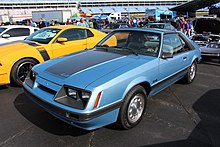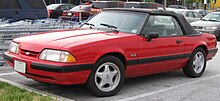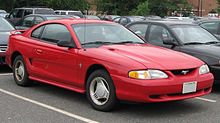1979-2004 MUSTANG
| Third generation (1979–1993) 1985 GT hatchback 1987–1993 convertible 1979 Ford Mustang notchback coupe Main article: Ford Mustang (third generation) The 1979 Mustang was based on the larger Fox platform (initially developed for the 1978 Ford Fairmont and Mercury Zephyr). The larger body with an increased wheelbase yielded more interior space for four passengers, especially in the back seat, as well as a larger capacity trunk and a bigger engine bay. Body styles included a coupe (or notchback), hatchback, and convertible. Available trim levels included an unnamed base model (1979–1981), Ghia (1979–1981), Cobra (1979–1981, 1993), L (1982–1984), GL (1982–1983), GLX (1982–1983), GT (1982–1993), Turbo GT (1983–1984), LX (1984–1993), GT-350 20th anniversary edition (1984), SVO (1984–1986) and Cobra R (1993).[52] Engines and drivetrains carried over from the Mustang II including the 2.3 L I4, 2.8 L V6, and 4.9 L V8 engines. A troublesome 2.3 L turbocharged I4 was available during initial production startup and then reappeared after undergoing improvements for the mid-year introduction of the 1983 turbo GT. The 2.8 L V6, in short supply, was replaced with a 3.3 L I6 engine during the 1979-model year. That engine was ultimately replaced with a new 3.8 L V6 for 1983. The 302 cu in (4.9 L) V8 was suspended after 1979 and replaced with a smaller, 4.2 L V8 which was dropped in favor of the high output 302 cu in (4.9 L) V8 for 1982. From 1979 to 1986, the Capri was domestically produced as a Mercury-badged version of the Mustang, using a few of its own styling cues. The third-generation Mustang had two different front-end styles. From 1979 to 1986, the front end was angled back using four rectangular headlights, known by enthusiasts as "four eyes". The front end was restyled for 1987 to 1993 model years to reflect the contemporary, rounded-off "aero" style of the Ford Taurus using flush-composite headlamps and a smooth grille-less nose. The Mustang was selected as the 1979 Official Indianapolis 500 Pace Car with replicas sold to the public. Its special body-appearance parts were adapted by the Cobra package for 1980–81. 1982 marked the return of the Mustang GT (replacing the Cobra) which used a specially-modified high-output 302 cu in (4.9 L) engine. 1983 saw the return of the Mustang convertible after a nine-year absence. The front fascias of all Mustangs were restyled, featuring new grilles, sporting "blue oval" Ford emblems for the first time. 1984 introduced the high-performance Mustang SVO, which featured a 2.3 L turbocharged and intercooled four-cylinder engine and unique bodywork. The Mustang celebrated its 20th anniversary with a special GT350 model in white with red interior and red lower-bodyside rocker stripes. 1985 Mustangs received another front-fascia restyle. In response to poor sales and escalating fuel prices during the early 1980s, a new Mustang was in development. It was to be a variant of the Mazda MX-6 assembled at AutoAlliance International in Flat Rock, Michigan. Enthusiasts wrote to Ford objecting to the proposed change to a front-wheel drive, Japanese-designed Mustang without a V8 option. The result was the continuation of the existing Mustang while the Mazda MX-6 variant had a last-minute name change from Mustang to Probe and was released as a 1989 model. The Mustang received a major restyling for 1987, including the interior, which carried it through the end of the 1993 model year. Under the newly established Ford SVT division, the 1993 Ford Mustang SVT Cobra and Cobra R were added as special, high-performance models. Fourth generation (1994–2004) 1994–1998 coupe 1999–2004 GT Main article: Ford Mustang (fourth generation) In November 1993, the Mustang debuted its first major redesign in fifteen years. Code-named "SN-95" by the automaker, it was based on an updated version of the rear-wheel drive Fox platform called "Fox-4." The new styling by Patrick Schiavone incorporated several styling cues from earlier Mustangs. For the first time since its introduction 1964, a notchback coupe model was not available. The door windows on the coupe were once again frameless; however, the car had a fixed "B" pillar and rear windows. The base model came with a 3.8 OHV V6 3.8 L (232 cu in) engine rated at 145 bhp (108 kW) in 1994 and 1995, or 150 bhp (110 kW) (1996–1998), and was mated to a standard 5-speed manual transmission or optional 4-speed automatic. Though initially used in the 1994 and 1995 Mustang GTS, GT and Cobra, Ford retired the 302 cid pushrod small-block V8 after nearly 30 years of use, replacing it with the newer Modular 4.6 L (281 cu in) SOHC V8 in the 1996 Mustang GT. The 4.6 L V8 was initially rated at 215 bhp (160 kW), 1996–1997, but was later increased to 225 bhp (168 kW) in 1998. For 1999, the Mustang was reskinned with Ford's New Edge styling theme with sharper contours, larger wheel arches, and creases in its bodywork, but its basic proportions, interior design, and chassis remained the same as the previous model. The Mustang's powertrains were carried over for 1999, but benefited from new improvements. The standard 3.8 L V6 had a new split-port induction system, and was rated at 190 bhp (140 kW) 1999–2000, while the Mustang GT's 4.6 L V8 saw an increase in output to 260 bhp (190 kW) (1999–2004), due to a new head design and other enhancements. In 2001, the 3.8 L was increased to 193 bhp. In 2004, a 3.9 L variant of the Essex engine replaced the standard 3.8 L mid year with an increase of 3 ft⋅lb (4 N⋅m) of torque as well as NVH improvements. There were also three alternate models offered in this generation: the 2001 Bullitt, the 2003 and 2004 Mach 1, as well as the 320 bhp (240 kW) 1999 and 2001, and 390 bhp (290 kW) 2003 and 2004 Cobra. Ford Australia This generation was sold in Australia between 2001 and 2002, to compete against the Holden Monaro (which eventually became the basis for the reborn Pontiac GTO). Due to the fact that the Mustang was never designed for right-hand-drive, Ford Australia contracted Tickford Vehicle Engineering to convert 250 Mustangs and modify them to meet Australian Design Rules per year. The development cost for redesigning the components and setting up the production process was A$4,000,000. Sales did not meet expectations, due in part to a high selling price. In total, just 377 Mustangs were sold in Australia between 2001 and 2003. For promotional purposes, Ford Racing Australia also built a Mustang V10 convertible, which was powered by a Ford Modular 6.8 L V10 engine from the American F truck series but fitted with an Australian-made Sprintex supercharger. |
Third & Fourth generation (1979–1993) & (1994-2004) |





